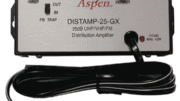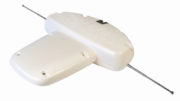Right now, amplified antennas are all the rage. They promise small size and big performance, and with the right amplifier and the right situation, they deliver. However, there are two kinds of antenna preamps — active and passive — and if you choose the wrong one you could end up with problems. So, let’s take a good long look at why you would want an amplified antenna at all, and whether a passive or active preamp is right for you.
Do you even need an amplifier?
The truth is many people don’t need an amplified antenna. Digital broadcasting makes amplified antennas less important because digital signals don’t fade out the same way analog ones do. They either work or they don’t, which is why you very rarely see snow on an HD picture.
In some cases, an amplifier can actually hurt your reception by creating a signal that’s too strong (called “overdriving”) or by adding noise to the line which actually makes the antenna signal harder for your TV to interpret. It’s important to choose a “low noise amplifier” that doesn’t create problems.
An amplifier is best used to compensate for a long cable run between the antenna and the television (or the splitter that feeds multiple televisions. A typical, brand new antenna cable will lose about 5dB per 100 feet, and you’ll lose even more if you’re using an old, cheap or worn cable. An antenna amplifier will help you keep the signal strong as it travels down to your TV.
What’s all this “active/passive” stuff?
Here’s where it gets confusing. If you have an active amplifier, then the signal only flows through it when the amp has power. If the power supply gets unplugged, or if you’re using the wrong kind of cable, the amplifier won’t let any signal through.
A passive amplifier will let the signal pass through even if there’s no power. This is a benefit if someone kicks the power supply out of the wall, if the cable you’re using doesn’t actually carry power (more on that later) or if there’s some sort of problem with the amplifier circuitry. You may not get the same great reception, but generally you’ll get something.
So clearly a passive amplifier is a better choice, even though that doesn’t sound like it would be right. You want an amp that doesn’t stop the signals from coming to the TV whenever that’s possible.
So what’s this about the cable not carrying power?
There are two kinds of cables: those with copper-clad steel (essentially thin copper plating) in the center and those with solid copper in the center. The solid copper ones are more expensive and most home stores don’t sell them.
This is important because the solid copper ones can send electricity up the cable as well as getting signal down it. The copper-clad steel ones aren’t nearly as good at this, meaning that if you install a preamp with the wrong kind of cable, chances are you’re not getting enough power to the amplifier. It might not turn on and you’ll have no signal at all. The worst case scenario would be the amplifier turning on when you install it and failing within a few months because the wire starts to weaken or gets pinched.
So the bottom line is…
You want an antenna with a passive amplifier if possible. There aren’t that many of them, but our friends at Televes make standalone amplifiers and amplified antennas with passive technology. They’re one of the few people who do. It takes extra cost and extra engineering to build an antenna amplifier so that it will pass the signal even without power, but you’ll definitely be glad you invested in a Televes product.





